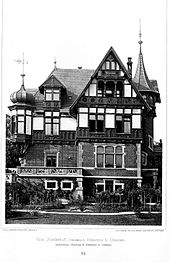Villa Fliederhof
The Villa Fliederhof was a bourgeois house in Dresden - Blasewitz , Goetheallee 26. It was built in 1893 and destroyed by fire in 1979.
history
The villa was built between 1892 and 1893 based on designs by the Dresden architects Schilling & Graebner for the actor and co-founder of the German Theater Berlin Sigward Johannes Friedmann . In 1905 the German-American bookseller Salomon Zickel (1829–1916), a multiple millionaire, acquired the Villa Fliederhof as a retirement home and lived there until his death. After the First World War , the villa was sold to Wilhelm and Wilhelmine Schuncke. The Schuncke family has been one of the leading families of musicians since the Baroque era and has produced numerous orchestral musicians and soloists across Europe over several generations. Under her leadership, the Villa Fliederhof developed after 1918 "into a center of European music care".
In 1924, at the invitation of the Schuncke family , Sergej Rachmaninow came to Villa Fliederhof for the first time as a guest. In the following years he stayed regularly with his family in the villa and also hosted the wedding of his daughter Irina here.
In 1958, the Dresden graphics workshop was founded in Villa Fliederhof. The Schuncke family, as the owners of the villa, lived in Germany after the end of the Second World War . Since they assumed they would never get their property back in the GDR , they wanted to donate the villa to the Dresden Music Academy in 1970 . Since the donation was not politically wanted, the family had to go to the doctor Dr. Flat-own the villa for a low price. The part of the Schuncke family who remained in Dresden then also moved to West Germany, a few items from the high-quality facility could also be used as souvenirs thanks to an expert opinion by his friend Max Seydewitz , former general director of the Staatliche Kunstsammlungen Dresden , as "worthless for the people's possession" get picked up. After a family drama, the house burned down in 1979, in which the Flach and their 13-year-old son died. The 17-year-old daughter and her three-year older brother survived seriously injured. Scores personally dedicated by Richard Strauss , which belonged to the singer Senta Kutzschbach, who also lives in the house, burned, as did the rest of the furnishings.
The ruins of the villa were demolished and the property was acquired by the Dresden-Meißen diocese . After the fall of the Wall , the property was sold again and two town villas were built on.
Since May 9, 2010, a memorial plaque on the property reminds of the fate of the building and the owners and guests of the villa.
Building description
The building in the style of historicism had an asymmetrical facade design and a complex roof landscape of interpenetrating pitched and hip roofs with differently shaped tower domes . The upper floors were built in half-timbered construction.
literature
- Wilhelm Kick (Ed.): Modern new buildings. ( Portfolio ) 2nd year, Stuttgarter Architektur-Verlag Kick, Stuttgart 1898, plate 82.
Web links
- Villa Fliederhof on Dresdner-Stadtteile.de
Individual evidence
- ↑ Lothar Poethe: Millions of booksellers in the Kingdom of Saxony before the First World War and a comparison with those in the Kingdom of Prussia . In: Thomas Fuchs, Christine Haug, Katrin Löffler (Eds.): Leipziger Jahrbuch zur Buchgeschichte . tape 26 . Harrassowitz Verlag, Wiesbaden 2018, ISBN 978-3-447-11151-5 , pp. 260-262 .
- ↑ The villa "Fliederhof" . In: Potz Blitz , 6th year, 1st edition, February 2010, p. 10.
- ↑ 50 years of the Dresden graphics workshop , meindresden.info, July 25, 2008.
- ↑ Tobias Wolf: The legacy of the Schunckes. In: Saxon newspaper . December 23, 2013, p. 3 , accessed July 9, 2015 .
- ↑ Klaus-Dieter Prskawetz: Sergej Rachmaninow in Blasewitz: 90 years ago began his five summer stays in the "Fliederhof". In: Blasewitzer Zeitung. July 18, 2014, accessed July 9, 2015 .
- ↑ Blackboard on Goetheallee reminds of famous musicians . In: Sächsische Zeitung , May 5, 2010.
Coordinates: 51 ° 3 ′ 23.5 ″ N , 13 ° 47 ′ 52.1 ″ E


